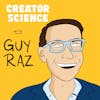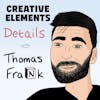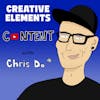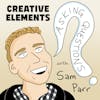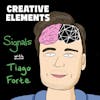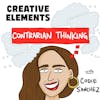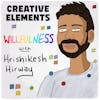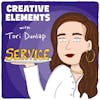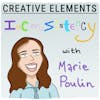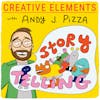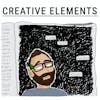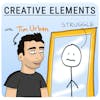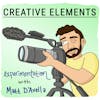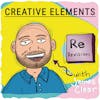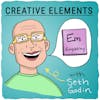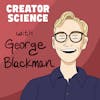
#162: George Blackman – How to script your videos like Ali Abdaal and Ed from Film Booth.
Play EpisodeGeorge Blackman is a scriptwriting consultant for top YouTubers.
WATCH
▶️ Watch this episode on YouTube
***
EPISODE DESCRIPTION
George Blackman is a YouTube scriptwriter who’s been hired by YouTubers like Ali Abdaal, Mike Shake, and Ed from Film Booth to write videos for them.
Scripting is one of THE most important parts of the video-making process that you may be overlooking – and George says it can make or break your video.
So in this episode, you’ll learn
- How a great video starts
- The 4-hat writing process to make better videos
- Tips for finding and hiring a scriptwriter
- And how to craft the perfect Call to Action to end your videos
Full transcript and show notes
George's Website / Script Templates / Newsletter / Twitter / LinkedIn
***
TIMESTAMPS
(00:00) The Secret Scriptwriter Getting Millions of Views
(01:20) How to Start a Video
(05:08) The Biggest Writing Mistake YouTubers Make
(06:37) Get Full Creative Control of Your Videos
(09:43) Do This Before You Start Writing
(12:02) 4-Step Process to Writing the Perfect Script
(16:42) How to Write to Engage the Audience
(22:30) Why You Should Hire a Scriptwriter
(24:33) Where to Find a YouTube Scriptwriter
(27:36) Crafting the Perfect Call to Action
***
CONNECT
🙏 Make a guest or mailbag request
📝 Check out our curated Playlists
***
SPONSORS
💼 View all sponsors and offers
***
SAY THANKS
💜 Leave a review on Apple Podcasts
Learn more about your ad choices. Visit megaphone.fm/adchoices
Jay Clouse [00:00:00]:
Listen to this clip.
George Blackman [00:00:01]:
And in doing so, he side stepped an absolutely massive financial risk that not many full time YouTubers ever think but I'm gonna come back to that. So why has Thomas Frank pretty much stopped posting on his main channel? And why has that allowed him to make even more money than ever?
Jay Clouse [00:00:16]:
Did you see what he did there?
George Blackman [00:00:18]:
Essentially, the audience needs to know pretty much at all times what it is they're waiting around for next. We're solving the ultimate question. How does he make so much money? That's what we're weighing around for. but not losing sight of the fact that you need to have these mini payoffs kind of throughout the video that serve as building blocks to that ultimate thing,
Jay Clouse [00:00:34]:
That's George Blackman, a YouTube scriptwriter who's been hired by YouTubers like Ollie of Doll, Mike Shaikh, and Ed from film booth to write videos for them. like the one you just saw. Scripting is one of the most important parts in the video making process that you are overlooking. George says that it can make or break your video.
George Blackman [00:00:52]:
If you want that full creative control, as I say, you, you need to know what all the beats are that you're gonna hit, unless your audience knows, why am I giving this guy or girl my time for the next minute? it's very easy for them to just think I can't be bothered to wait another 10 minutes to get to the end of this.
Jay Clouse [00:01:05]:
So in this episode, you'll learn how a great video start before hat writing process to make better videos, tips for finding and hiring a script writer, and how to craft the perfect call to action to end your videos. Where does a great video start? How do we how do we get this thing started so that we're giving ourselves a good chance for this video working?
George Blackman [00:01:28]:
So the idea generation is obviously a big one, and I know you've spoken about that with Patty Galloway, and that's like the big thing that kind of comes up a lot of the time is is the idea generation. I'm usually less involved in that phase. My role tends to come in as, like, how do we once we've got that idea, how do we frame it? And that that's a huge one. And I think something creators often think is like, oh, I'm excited to talk about this topic, and I know roughly what I would want to say about it. Maybe it comes from conversation you've had with somebody, at a cafe or at a pub or something. And it feels like this is something I could intuitively just talk really compellingly about for a while. But in my experience, and what I find with the the one to one calls that I do with creators is that your first idea is often not gonna be the best the best one. So I take an example. I was speaking to somebody recently who, they they wanted to talk about Hollywood reboots, right, which is obviously at the moment has been a trend for a little while now, the the kind of incessant rebooting of basically everything, we know and love from our childhood. And they came to me saying, like, I wanna I wanna talk about this. and that they they weren't fully sure, like, how to approach it. And their first instinct was like, well, why don't we just talk about you know, the pros and the cons of doing Hollywood reboot. Like, yeah, well, it's good. Well, it's bad, which is like cool. I get you could, you could do that. But by itself, that feels, again, like a conversation you might have with somebody down the pub. A second angle that we talked about and that they came to me with was, oh, why don't we talk about why Hollywood keeps doing it, right? Like, why when they have the option to make new and fresh and interesting things, do they continue to reboot stuff? But again, that seemed like a question that you can answer immediately. either intuitively or you can Google it, but the answer is money because it makes money. That's not an interesting thing. And if you're gonna try and delay revealing that answer to your audience, for 10, 15, 20 minutes, or or like, for hours, if it's a video essay, potentially, that's not something that is gonna convince many people to stick around because it's quite intuitive. But then we landed on the idea of, oh, what if we talk about why do we keep going to see it? Why is it something that I know I'm not going to enjoy. In all likelihood, balance of probability, I've seen enough reboots. I've been frustrated enough times going to the the movies, that I'm not gonna enjoy seeing this, but why is it that I keep giving Hollywood my my money? To be honest with that question easily, it makes the money. Who makes them that money? Me, what so, like, it's almost like an invasive look into, like, my own behavior. Like, we get it. The sort of thing, I think I will have it will have crossed my mind as an audience member in the past, having that presented in front of you, it's like, why? I can't remember the title we came up with, but presenting it framing it as a look into, like, you and your behavior. Again, that's quite a specific example, but I think that's that's basically the kind of the checklist that we you want for how you frame your video. It's gotta be something that's interesting for you. It's gotta be something that's deeply interesting for your audience. it's got to evoke some kind of emotion, like the kind of emotional response I was having just then the, like, kind of frustration or, or whatever it is, and then it's got to open multiple curiosity apps. It's gotta be the kind of thing you couldn't just Google and find out very, very quickly. Because, again, we're trying to convince people to give us a significant amount of their time when at the click of a button, they've got thousands of other choices. So hitting on that right framing of the idea is, is is paramount.
Jay Clouse [00:04:35]:
When I think I'm hearing and tell me if I'm hearing this incorrectly -- Yeah. -- but, I'm thinking out loud a little bit. Ideas are not the same as topics. Like, you can have a topic that you wanna explore. That is not inherently the idea for the video. The idea is almost like a Russia nesting doll inside of the topic to say, how do I how do I frame and and almost, like, carve out how I'm going to address this topic.
George Blackman [00:05:02]:
Yeah. That is exactly right. Couldn't have put it better. That's the 66 thing done. So for what I just said,
Jay Clouse [00:05:08]:
So what are some of the trends you see as to what that behavior is or what what mistakes people are making early on and throughout the beginning portion of video? that causes people to lose interest and tune out?
George Blackman [00:05:20]:
It usually comes down to the idea of payoff, as its umbrella kind of term, essentially, the audience needs to know pretty much at all times what it is they're waiting around for next, which sounds pretty obvious. But it can be very easy, I think, when you are the process of making a 10 minute video to forget to signpost those things frequently throughout throughout the video. So although might be doing a tutorial video where you're showing them. By the end of the video, you're gonna know how to do this, or it might be, for example, I wrote a a a breakdown of how Thomas Frank makes However, many 100 of 1000 of dollars he makes a month. We're solving the ultimate question. How does he make so much money? That's what we're weighing around for, but in the kind of you know, the the 7, 8 minutes before that, what are the things that we are the little kind of, moments, the little tidbits that we are excited to find out about in the next minute or 30 seconds even. And so I think it's about figuring out, first of all, what that big the grand payoff is I've actually written about this, and the the newsletter that I've written that's going out today is is about identifying that grand payoff, but not losing sight of the fact that you need to have these mini payoffs kind of throughout the video that serve as building blocks to that ultimate thing. And unless you're signposting that, unless your audience knows, why am I giving this guy or girl my time for the next minute? it's very easy for them to just think I can't be bothered to wait another 10 minutes to get to the end of this.
Jay Clouse [00:06:38]:
These types of sign posts and planning for how and when the payoffs happen throughout the video. It sounds like something that's difficult to do without thought or intention. Yes. Okay. It seems like I'm probably not gonna walk in, hit record, and just do these things really well.
George Blackman [00:06:56]:
You're right. Yeah. This is actually, funnily enough. earlier, this this week or last week, maybe I did Justin's create a debate podcast, and we were talking, about script writing and whether you should script or whether you should just wing it. there's, of course, a place for just winging it. And especially, I think the conclusion we came to is when you're maybe first getting started in all of this, it feels like a lot to learn how to be a videographer and a sound mixer and also a script writer and a storyteller and all this stuff, maybe it is okay to just get some bullet points and just get used to speaking to camera. But I think if you want total creative control over the package that you're putting out, there has to be some thought when you sit down, you you wanna have it mapped out as as much as you possibly can. And it's okay. It's not like you have to stick word for words to what you've written if you feel like you need to skip over a little bit or you feel the urge to just like rephrase something in the moment, totally fine. But if you want that full creative control, as I say, you you need to know what all the beats are that you're gonna hit. Because if you're gonna sit down and just start talking, it's very easy to forget what did I say a couple of minutes ago? Have I teed this up properly? Have I properly foreshadowed what's coming next? Does this make sense as a step by step to my audience? to reach that grand payoff, it's harder to tell if you haven't got a plan.
Jay Clouse [00:08:04]:
I love that you you call out the fact that you don't have to have the entire process dialed to attend in all the steps within it when you get started because I think that's really important for a lot of people listening to hear, which is like, yeah. We're laying out How people at the top level are approaching this? And you can have that in your, windshield, I guess. It's not your rear view mirror. have that in front of you and know that's what you're working towards, but you don't have to be there right now. After a quick break, George and I dive into the specifics of writing an effective script. So stick around. We'll be right back. And now back to my conversation with George Blackman. So we have an idea that hits those checkboxes, and we feel good about it. Now what happens to get this thing written?
George Blackman [00:08:51]:
The key thing, and it feels like a real annoyance for a lot of people, and I know as soon as you hear the words come out my mouth, it's gonna feel like, ugh, an immediate stomach drop, but drafting up an audience avatar so you can be laser focus on basically everything, the language you're using, how you're constructing your scripts, the topics you choose, all of that, you you just you need to know who you're talking to, and it's the same, in marketing. It's the same in everything. Like, this is basically marketing.
Jay Clouse [00:09:16]:
In this in this idea of an audience avatar, are you suggesting that that's something I do for my channel and each video is a addressing that audience, or are you saying each video we need to create this avatar?
George Blackman [00:09:29]:
It depends. Usually, I mean, have one one for your channel is definitely what you would need overall, but there will be sometimes where maybe you're looking to reach an audience that is not part of your usual cohort, you're actually looking to grow the channel in a different direction, In which case, and I know this is a bit of a stressful annoying thing to do. You could consider doing that. I think it will make your life down the line when you're actually coming to write it. much easier because it actually cuts off the number of choices you have at a given point for how you structure it, the language you use, Again, we can come more onto that, in a moment, but, it's certainly an option you have, but you should definitely have one for your channel as a whole. Yeah.
Jay Clouse [00:10:05]:
And when you're doing this, what level of depth are you thinking? Are you naming this person? Are you talking about their demographic information? Like, when is the avatar clear enough?
George Blackman [00:10:17]:
I, I think it depends. I've, I've, well, when I worked with Ali, I saw for a course that he was launching, somebody who was doing the whole, like, they have a name, they have an exact occupation, like, all of that stuff. I've never tended to go that deep, and that may be an error on my part. For me, it's like, just using all the opportunities you have to speak to your audience and constructing an image, as best you can just from the responses they they give. it's then gathering all of that information into a notion table or a document or something like that and kind of just piecing together from that who it is that you're talking to. I've never gone as far down the road as naming them, but that is something that some people prefer to do. I just that that to me feels like one step beyond, what I need to do, I'd rather come with writing.
Jay Clouse [00:11:01]:
Alright. So we've got the avatar dialed in. Once you have that, what's the next step?
George Blackman [00:11:06]:
then it's kind of a free for all, in terms of the ideas that you're getting down on the page. Right? And this is, the kind of process that I follow when I'm writing basically any script. It's like a 4 hat structure. And the first hat is what I call the artist where it's free flowing. You're just getting ideas down on the page. You don't have to think about the structure. You don't have to think about how one thing is gonna lead to the next. All you really need from all of that is to have figured out what that grand payoff is, what the big moment that we're gonna focus on at the end is what the audience is sticking around for. But beyond that, it's just what do you instinctively think this video should contain? and you just go for it, and you don't think.
Jay Clouse [00:11:44]:
That's my favorite hat to wear. So four hat structure, number 1, artists. What's number 2?
George Blackman [00:11:48]:
The second hat is the architect's hat. Is that a hard hat? Would they would they wear a hard hat walking around it?
Jay Clouse [00:11:53]:
I think so. I think that well, I don't know. That's that's like a sport like a construction hat.
George Blackman [00:11:57]:
More of a construction hat. Okay. Well, you know what? Maybe that works. the architect, the constructor, however you like to phrase it. And that is where you start to flush out that structure, right? And that's where from all these ideas that you've got, you start to eliminate the ones that you realize aren't gonna be super interesting. And you figure out the the necessary steps that will build up towards that final payoff. And this is a key point, especially when working with clients, where you need to basically get that ok'd with them, because, again, they'll have had this idea with you. You'll have kind of figured out what the framing is gonna be, but now you need to clarify with them whether or not this is the order of events they wanna talk about. how they had kind of foreseen it in their in their mind. So getting that structure dialed in is is part
Jay Clouse [00:12:37]:
2. Let's get going. Part 3.
George Blackman [00:12:39]:
The third hat is the writer's hat. I don't know what kind of hat a writer wears. I I'm not much of a hat wearer myself. I maybe I need to, like, commission my own hat I don't know. So that's where, again, you're now starting to expand the bits in between this kind of lists that you have right where you've got all the key points that you're gonna Now you're connecting the dots, essentially. There needs to be something progressing, regressing, or changing at any point. in your script. And it can be hard to see this before you sit down, and and start to really write it out in full and something that I've learned from one of my clients recently. is that at the top of the scripts now, I'm writing a couple of sentences about what is the goal? So the goal either of if it's an entertainment video, the person who's in it doing the thing, or if it's something, educational, what is the goal of the person watching? Like, what do they want? And what does success look like? Then what does failure look like? So again, entertainment video, what does it look like? What what is it they do that is bad and takes them away from the goal? sees them regress away from the goal. Or again, if it's the, the viewer we're talking about in an educational video, it's, what are the kind of, obstacles to their success? What are the things that they're worried about, the objections they might have And then the final the third thing is emotion. What emotions might they feel as a result of either the successes or the failures? Just having that at the top of my script is something I then refer back to you constantly. So when you're writing the scripts, you wanna be thinking, is anything happening here in this kind of paragraph or this segment of the video, are we progressing towards something? Are we failing away from something, or is there some kind of change of emotion going on? And again, you're trying to avoid when you're doing all of this is too much task switching. So it's kind of, again, like, almost another free flowing point where you're not thinking too much about retention at this point, you're just thinking can I get from a to b to c in a way that makes sense? Maybe you're thinking of kind of half form b roll ideas, and visual cues and things that you might wanna be putting in with all of this. But, again, the key thing here is making sure that by the end of your time as the writer, you've got the thing that gets you from the start. to the finish. And that brings you on to the wizard taps. And this is where you now start thinking about the retention stuff. And there's, I guess, a lot of stuff we could talk about here, but particularly when it comes to payoffs, it's thinking and and this is something I do. Sometimes it is literally going through the video and highlighting every time I think there is a moment where the audience is gonna go, oh, or they feel like they've learned something that they didn't know before, going through and highlighting that stuff, makes it incredibly visually evident if you have huge ways of the script where the audience isn't learning anything, where they necessarily don't know what's coming up next. And that's when you can really start to play around with that structure and think, okay, where are these kind of reveals that I wanna put into the script? Where are these these big moments of emotional release or whatever it is. It's hard to be too specific when we could be talking about a tutorial or an entertainment video or Whatever it is, I really swear by highlighting whatever it's payoffs or it could be something else, but it helps you get a sense of the visual structure of the script, and and that's where you can start to to rearrange things?
Jay Clouse [00:15:42]:
I think the tendency that I have when I get into script writing is being very literal and almost like maybe too economical. You know, it's it's very utilitarian, especially in the first draft where it's like, alright. I wanna explain this thing to you. And if I'm not careful, I end up with, like, a 2 minute video because I've just, like, said everything the most efficient way possible, but I realized it's not actually necessarily helping the viewer because saying something efficiently doesn't mean that it's then heard Understood. So talk to me about what I'm wearing my writers hat, which I think is where a lot of your specialty comes in, and the wizard, as you're but I think the writer is where a lot of people are probably struggling the most, obviously. How does that process look and feel? You know, I wanna understand more about how this looks when you're actually digging in and and writing the script.
George Blackman [00:16:37]:
Yes. I I really like what you said there about, efficiency won't necessarily equal something learned and remembered, essentially. Something really cool that I picked up from somebody that I was doing a one to one with actually, I think I was doing a I was reviewing one of one of their scripts, and I actually saw in their notes, they had this, this kind of thing in, like, bold, starred, text. It was, make the audience feel smart, and that really stuck with me. And that's something that I think about a lot now. So the example you just gave, right, where you're super efficient and you talk through the video and you're done in 2 minutes, they've got the information. That's all well and good. but it's not memorable, and they haven't had to engage particularly hard to receive that information. So something I that I see all the time with scripts that need a little work, and it's such a simple fix, is giving those payoffs a little bit too early and then feeling like to pad the runtime, you then have to talk about it more after you've kind of given away what the answer is. And that might seem like something, you think, well, I wouldn't do that if I've given away the the answer, why would I keep talking about it? But you see all the type, like, listicles are a real bandit for this where you're like, okay, ten things that I can't go without when I leave the house. And it's like, number 1, my house keys, and immediately watching that, thinking, well, I know why your house keys because you need to get back in the house. It's easy. But then with this sort of list score, you'll see them then say, I always have my house keys with me, I always keep them in my pocket because I need to remember where I've kept them so that when I get back to the house late and I, I, I get it. I, I got it. I figured this out 10 minutes ago. Again, not making the audience your smart. You give that payoff a little later. And this is, again, I I know you spoke with Ed about this, and this is his real kind of, zone of genius is doing something that gives the audience a clue as to what's coming up, but without revealing what it is we're gonna talk about. So he's like the king of YouTube metaphors, right? and that was something that was really fun when I was working with him. It was was getting to, come up with really interesting metaphorical ways of explaining things. And so as I say, the tendency to pad things out, there's no point doing it if you've already given the payoff. You need to come up with a metaphor or give them a kind of interesting route in to the point that you're about to make before making the point. And, again, you can do this really easily. Literally just switch the order they come in the script?
Jay Clouse [00:18:59]:
this is good. This reminds me of a video we did on the channel about, my revenue streams from last year. And it's like here, the the revenue streams that I put in place. Those videos, a lot of people watching that are probably like, just tell me the 7 things. And I I felt I felt like I needed to have context in between, but it was a struggle for, like, what you're saying. Context that is additive and useful versus me just trying to pad the runtime. That's a good way to think about it. And this is why I hate reading any article that's written for SEO because they're all this way. Why when I think about some of my best work or some of the work that's been received the best, it's when I kind of presume intelligence on the part of the audience. And it's it's having a high level conversation without having to dumb it down much and assuming that people will keep up with it.
George Blackman [00:19:46]:
You're right. In fact, I had, the the the boxer who was training Michelle Kare in that recent video she did. I mean, if you've seen this incredible video, that she she made a couple of months ago. The the the I think it was the the bronze British Olympic boxer from 2008 order was it was the guy who was training her in that video. And he actually came to me for a video, review, which I put in my newsletter, I think this is one of the most simple examples of showing how you can, like, easily switch these things over is he was doing a video about, like boxing techniques if you're a short person, fighting a taller person. And every time he would be like, the technique is this. I'm gonna move much closer very quickly, and that means I can get a punch in before they even see me. And then he would demonstrate it. And my suggestion to him was like, how how simple is this? Like, you, this is perfect opportunity to show something visually and literally ask the audience, like, can you see what I'm doing here before then explaining it because that's what we talked about. It engages the brain. It becomes like a puzzle. Immediately, they're now watching it thinking, Oh, I think I is he doing the thing where he moves really quickly so that they can't get a punch in? and then he reveals it, and you get this little dopamine hit because you're like, oh, I worked that out. I wasn't just given it on a plate. I wasn't told it. I had to engage and figure it that's just a way more satisfying experience for the deal.
Jay Clouse [00:21:04]:
This first cross platform too. I realized this is what makes some of Patty Galloway's threads really good on Twitter is he'll give a little bit of information. He'll give, like, a views or impressions chart and say, Why do we think this happened? And -- Replies just fill up with people making guesses really, really useful to engage the viewer with the content. That's that's a really good way of thinking about it. Yeah. When we come back, George and I talk about how to find a great script writer. So don't go anywhere. We'll be right back. And now please enjoy the rest of my conversation with George Blackman. Is there something you believe to be true could be related to script writing. It could be related to YouTube. It could be related related to anything as a creator. Something you believe to be true, but you do not yet have the data to support.
George Blackman [00:21:54]:
I think this is, something which I would say because my livelihood depends on it, but I believe that a lot of channels would benefit from hiring a script writer, but I think it's something that hasn't caught on yet as much as getting ahead or a thumbnail designer. Right? Most channels that move beyond a certain point that that taking themselves seriously, they'll end up with an editor or a thumbnail designer pretty soon. but a script writer is something that I think the ROI isn't always completely clear, and I think it is something that is maybe harder to onboard someone into that role because it's so much about, voice, which is not an easy thing to pick up. editing style. I mean, I'm not an editor, so I wouldn't want to get hundreds of angry editors, coming after me in the night, but I feel like you've got such a a clear visual reference for the style that you're trying to to mimic, that's something that you can start to pick up. Writing is is a lot more about you have to just spend so much time kind of listening, speaking out loud. I mean, I literally will sit here and read out loud in the voice of the person I'm trying to write for. the script that I've written for them, but it's a difficult thing to onboard. However, the ROI of a writer, I think overall is huge, whether that is just in a research capacity to save you that upfront time, but in having somebody on the team who is specifically devoted to thinking about the nuts and bolts structureable with this stuff in the way that we've spoken about today, it it takes a lot of time to sit down and really think through all of this stuff and I think a lot of teams would benefit from having a writer. I think it just comes down to having the patience to onboard somebody and even find somebody. I get this all the time. I get asked for recommendations all the time, and I don't know who to recommend, because there just aren't that many people that have come out the woodwork yet. I got 2 or 3 people that I will pass on, but I don't know that many people. So
Jay Clouse [00:23:45]:
-- Well, that's gonna be my next question is, how do we find these people? And if if the If the answer is, well, it still says a nascent medium or, like, practice for writers to be YouTube script writers for creators. I'm wondering if you have any thoughts around how to find somebody who you think could have the potential to learn this well.
George Blackman [00:24:05]:
One thing I've recommended in the past is getting somebody in as a researcher in the first place, where they don't have yet the responsibilities of thinking critically in the way that we've been speaking about today about how the video is gonna come together, but they are thinking about the kind of information that will go into that sort of video. and gradually, if you, keep them around for a certain length of time, they will just naturally throw osmosis start to pick up a little more about how the videos come together in the end. So that's it's almost like an apprenticeship, I suppose. You kind of got them in, at an earlier level, and you you let them learn as they go. terms of places to find them, I mean, YouTubejobs.co is is the only kind of hub that I'm aware of other than Twitter, but it it is hard. It is very hard. And all I can say in terms of people that have asked about this for editors is that getting an editor to share opportunities on their Instagram story or or something like that means you're more likely to get a swarm of the right kind of people, coming to the call, but it's it's hard for writers at the moment. It is to to try and find them.
Jay Clouse [00:25:12]:
We have an unfair advantage of as creators of Having distribution or having an audience of people who already know our work, it strikes me that it's probably helpful to look within your audience first. for people that might be high potential because they'll already have some level of baked in knowledge of your voice and familiarity with it. Of course, if you're trying to do something new and kinda expand beyond what you're doing, that might actually be a hindrance. But if you're like, you know what? I wanna keep doing what we're doing. working, we have kind of a a a platform and a pattern, then probably finding someone who's already familiar with their work is is helpful.
George Blackman [00:25:50]:
No. You're right. And, actually, I've got somebody who is helping me with my, script writing course at the moment who is somebody that was reading my newsletter for you know, 6 months or so, who was also a YouTube script writer as it, as it turned out, and she's proven to be invaluable in all of this and all, basically, what she was like, Hey, I'll, I'll help you write this this thing. if you're happy for me to just keep it at the end, essentially, and keep learning from you along the way, And that's something that's, like, super, super useful. And immediately, that's someone who I'm more likely to wanna pass on because I'm already getting a sense of of her capabilities. So, yeah, I think you make a really good point.
Jay Clouse [00:26:26]:
What haven't we covered here in the process so far, George? I've got the 4 hat structure. We've talked about writing this in a way that engages the viewer. and adding some signposts along the way for moving towards a payoff. What haven't we touched on here that you think is really important for somebody who's approaching, writing their next video script.
George Blackman [00:26:45]:
The call to action is is is a big one. A thread of mine has kind of been doing the rounds again more more recently with the kind of the closest thing to a hack I've ever found for YouTube and, obviously, caveat that with the fact there are none, but there's just a little change in the way that I've started doing my call to actions at the end. and I'm talking specifically about trying to get somebody to watch another video that just blasts the channel average click through at the end way out the water. Like, pretty much without fail, and I've started getting people DM ing me now with their results using this this exact same thing. This feels already exactly like the kind of spam ad you get on, like a dodgy website where it's like, how am I
Jay Clouse [00:27:28]:
I'm at the edge of my seat. I'm leaning in.
George Blackman [00:27:31]:
What a lot of people do is either they'll spend a lot of time, you know, thanking the video for watching and all good. Like, you wanna still be a pleasant human being. That's all good. I'm not saying we have to dispense with the pleasantries completely, but the the sense we give and again, this is something that Ed has talked about, is that we wanna give people the impression of the video that there's more to learn. But the simple way that I found of breaking this down is a 3 step thing. So first, link. And I'm not talking about the URL to a video. I'm talking a link back to something that you've been discussing in this video. so that it could seem that you're naturalistically now just building onto another point based on what you've already been talking about and what the viewer is already there watching. The next thing is curiosity gap. So you're going to relate something you've already spoken about in this video. You're gonna open a curiosity gap based on that thing. So the classic is, like, although you may have understood or you may have, enjoyed learning about x, you won't be able to properly apply it until you know y. And then the final point is the call to action slash promise. So the call to action being, so watch this video so that, and then you add the promise so that you can achieve whatever it is that they want to achieve. So, again, you're trying to root the emotion in something that they're clearly already interested in because they've watched this video from start to finish. is obviously relying on you again picking a video to send them to that is gonna be super, super relevant. But if you can make them feel like something they've watched in this video is incomplete, you really widen that curiosity gap and get them desperate to know what it is you have to have to tell them. So link curiosity gap and then the promise slash call to action at the end.
Jay Clouse [00:29:04]:
So you and I were just talking about how to engage the viewer in the video and what you're sharing with them. That's actually something that we talked a lot about with Ed on the recent video that we had here. So if you're watching this and you're interested in learning more about how to make your videos more interesting and to engage the viewer in storytelling, you should watch this video where I interview Ed from Phil Booth right here.
George Blackman [00:29:28]:
That was Killer. You're a you're a natural.
Most Popular Episodes
New to the show? Check out some of our most popular episodes.









